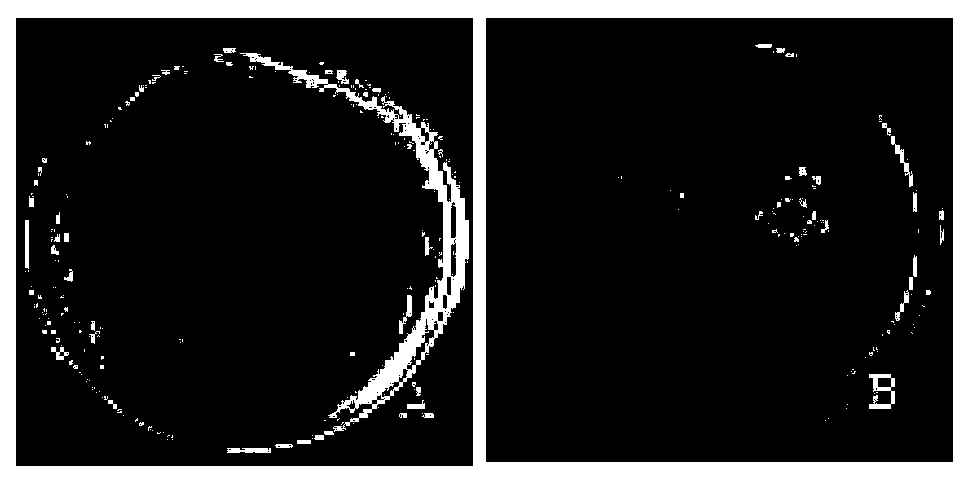A tree rhizosphere bacterium Bacillus mycoides jyz-sd5 and its application
A technology of JYZ-SD5 and Bacillus mycoides, applied in the field of microorganisms, can solve the problems of relatively few studies on the comprehensive performance of PGPR
- Summary
- Abstract
- Description
- Claims
- Application Information
AI Technical Summary
Problems solved by technology
Method used
Image
Examples
Embodiment 1
[0031] The bacterium JYZ-SD5 isolated from the rhizosphere of poplar in Shandong is preserved in the China Center for Type Culture Collection with the preservation number: CCTCC NO: M2018469.
[0032] 1) Physiological and biochemical measurements of the bacterial strain JYZ-SD5 were carried out referring to the "Berger Bacteria Identification Manual" and "Common Bacterial System Identification Manual", and the colony morphology and characteristics were described.
[0033] The colony of the strain JYZ-SD5 on the NA medium is nearly round, with irregular edges, milky white, no protrusion in the middle of the colony, moist and shiny ( figure 1 A, B). The bacterium is short rod-shaped, without flagella, Gram-positive bacteria, and green spores can be seen in the spore staining observation, indicating that spores are produced ( figure 1 C).
[0034] Strain JYZ-SD5 was positive in VP test, methyl red test, indole test and nitric acid reduction test, and could hydrolyze starch and ...
Embodiment 2
[0042] Example 2 Rhizobacteria JYZ-SD5 Nitrogen Fixation, Phosphorus Solution, Potassium Solution Performance Measurement
[0043] 1) Detection of nitrogen fixation characteristics: Inoculate the tested strains in nitrogen-free medium by streaking on a plate, repeat each treatment 3 times, place them in a low-temperature constant temperature incubator (MIR-553, Japan) at 28°C, and observe the bacteria continuously growth status.
[0044] 2) Detection of organophosphate-dissolving characteristics: inoculate the tested strains in the organophosphate-dissolving medium by three-point inoculation method, repeat each treatment 3 times, place them in an incubator at 28°C, and continuously observe the density of the transparent circle around the colony. Yes or no.
[0045] 3) Determination of potassium decomposing ability: adopt the method of liquid culture to inoculate the test strain into the liquid medium for detecting potassium decomposing, repeat each treatment 3 times, place it...
Embodiment 3
[0049] Example 3 Rhizobacteria JYZ-SD5 produces IAA ability detection
[0050] 1) Qualitative detection: Pick a single colony and insert it into King's medium B, incubate in a constant temperature shaker (Multitron Standard, Switzerland) at 37°C for 24 hours, draw 1 mL of bacterial liquid into a sterile centrifuge tube with a sterile pipette tip, add 4 mL of Sackowcki's After that, the color reagents were quickly and fully mixed, and the color was developed for 40 minutes at room temperature in the dark, and the color change was observed.
[0051] 2) Quantitative detection: Accurately weigh 10mg of IAA, first dissolve it with a small amount of ethanol, then dilute to 100mL with distilled water (concentration is 100μg / mL), and then dilute to 0, 4, 8, 12, 16, 20, 24μg / mL respectively , take 1mL of each concentration, add 4mL color reagent respectively, keep dark at 40°C for 40min, measure OD value at OD535, and draw a standard curve. Centrifuge the cultured bacterial suspension...
PUM
| Property | Measurement | Unit |
|---|---|---|
| tolerance concentration | aaaaa | aaaaa |
Abstract
Description
Claims
Application Information
 Login to View More
Login to View More - R&D
- Intellectual Property
- Life Sciences
- Materials
- Tech Scout
- Unparalleled Data Quality
- Higher Quality Content
- 60% Fewer Hallucinations
Browse by: Latest US Patents, China's latest patents, Technical Efficacy Thesaurus, Application Domain, Technology Topic, Popular Technical Reports.
© 2025 PatSnap. All rights reserved.Legal|Privacy policy|Modern Slavery Act Transparency Statement|Sitemap|About US| Contact US: help@patsnap.com



